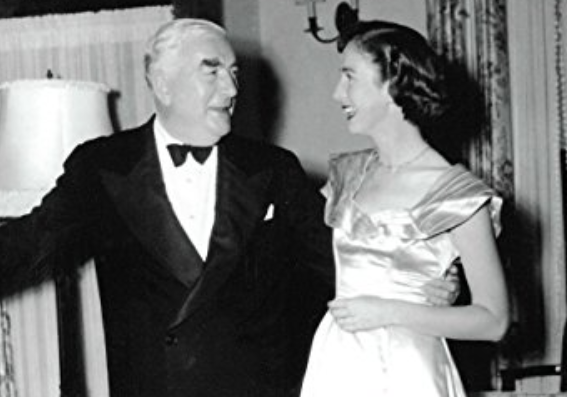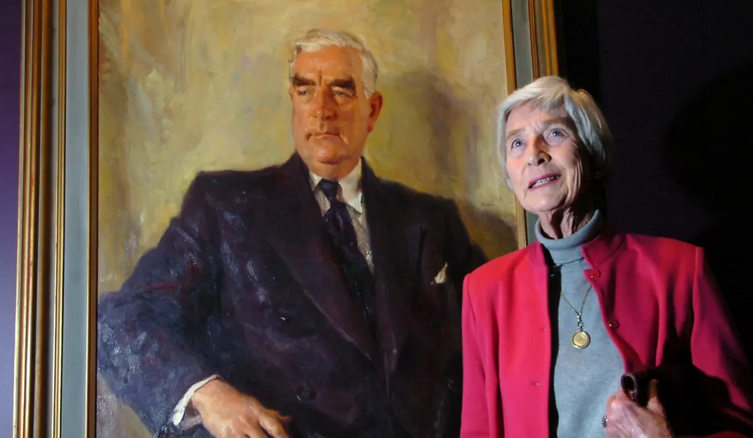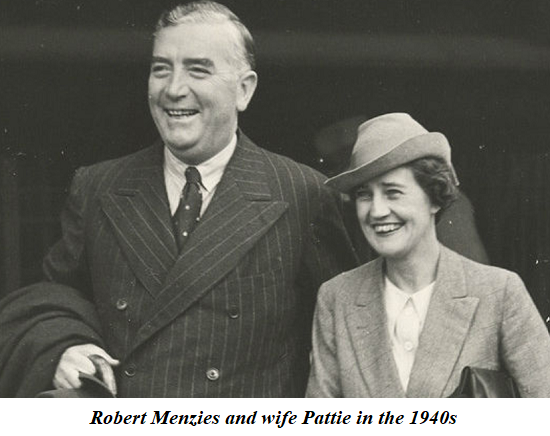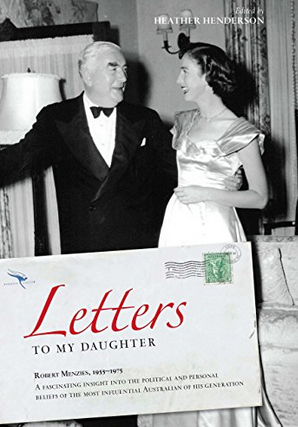
The Melbourne Argus announced on August 13, 1928:
“MENZIES – On the 3rd August, at Lancewood, Glenferrie Road, Kew, to Mr and Mrs Robert Menzies, of Howard Street, Kew, a daughter”.
That daughter was christened Margery Heather (always Heather), the youngest child, and then and forever the apple of her father’s eye. Heather’s mother, Pattie, had enjoyed a similar bond with her father, the manufacturer (later Senator) Jack Leckie. If Robert and Pattie Menzies were regarded as one of Australia’s great double acts, with their daughter they became a winning trifecta.
Robert Menzies had been elected a member of Victoria’s Legislative Council two months before Heather’s birth. The following year he became King’s Counsel, and later that same year he entered the Victoria’s lower house, the Legislative Assembly. When Heather was three her father was state attorney-general and 1st deputy premier. By 1934, he was elected to federal parliament as the member for Kooyong, the seat that sustained his career for another 32 years. Prime Minister Lyons made him federal attorney-general and minister for industry.
While Heather’s older brothers, Kenneth and Ian, boarded at Geelong College from 1936, Heather became a weekly boarder at Ruyton Girl’s School, Kew, which meant time at home on weekends. By war’s end Heather was a senior student at Ruyton. Described as “willowy, orthodontic bands and good at tennis”, she was already politically astute. Her father wrote, “her sotto voce comments in the galleries during speeches by such favourites as [Frank] Forde and [Eddie] Ward and [Doc] Evatt are really worth going a long way to hear”. By then Menzies was leader of the opposition and leader of the Liberal Party he had founded in 1945. He had already been prime minister for the first two years of the War. Heather would later recall her head mistress coming into the dormitory in April 1939 to say that her father had been made prime minister. “Well, none of us had the faintest idea what that meant,” she said, “but we thought it was obligatory to jump up and down and shout ‘Hooray, hooray’.”
One of his ministerial colleagues, Sir Alec Downer, observed how father and daughter seemed united by a ‘mystical understanding’ and assessed Heather as ‘the principal joy’ in Menzies’ life during the period he knew him. As Sir Alec wrote in his posthumous memoir, Six Prime Ministers (1982), “Despite her slim figure, she resembled him in facial features, sharing the same wit, incisiveness, some of his intolerances and, occasionally, that tongue which entertained audiences but sometimes lost friends.”

In 1951, two years after Menzies’ re-election as prime minister, The Lodge became Heather’s home. It was “like many other houses at the time” but with certain unique distinctions. She remembers, for example, busloads of tourists pulling up on National Circuit and staring while her parents had coffee on the terrace under the wisteria. “The Lodge, in those days, had a little two-strand wire fence around it. That’s all. Anyone could walk in and out — and they did”
She would accompany her parents to local events at Albert Hall and Parliament House and join her father on election tours. She fund-raised for the Red Cross and other charities across the country. Although she would have scoffed at the reference, Heather became the nation’s First Daughter.
Heather travelled with her parents on an unofficial visit to Europe in 1948, recalled being in London when Prince Charles was born and also being among the crowd outside Buckingham Palace calling for “Grandpa” George VI. The trio returned to London in 1953 as guests for the Coronation – as her parents were royal guests their costs were met by the state but, bizarrely, as Heather was a mere ‘official guest’ her costs were met by her father. She must be one of the last Australian survivors at the Abbey that day, June 2, 1953. National interest was intense. Heather at a pre-Coronation ball; Heather as a guest of the Marlboroughs at Blenheim and the Salisburys at Hatfield; what she wore and whom she met. The Australian press followed the Menzies’ every move. One might say ‘every movement’ as the Maryborough Chronicle splashed on June 30, 1953, towards the end of the visit, ‘MENZIES HAS GASTRO’.
Heather shared her account of the Coronation with a number of Australian papers. To sustain her for the seven-and-a-half hours, she chewed Ovaltine tablets. She even shared one with a VIP beside her and noticed the majestic Queen Salote of Tongo was popping them too. She recalled that as the Duke of Edinburgh paid homage to the newly crowned Queen, young Charles “pointed with great joy and could only have said: ‘Look, there’s Daddy.’ At the end of half an hour, they had great difficulty in persuading him to go, but eventually some persistent gentleman led him out by the hand.” On her return, for months she spoke to women’s groups in regional Australia of what she witnessed. From Badger Creek, Cowra and Dubbo to Healesville, Parkes and Wagga, she delighted with lines like Prime Minister Churchill “having everything on except the kitchen sink.”
In 1954, Heather accompanied her father, in her mother’s place, to the Prime Ministers’ Conference in London, spending the weekend with the Churchills at Chequers. Back in Canberra once more, she enjoyed tennis at The Lodge, and the occasional swim in Paddy’s Creek. She played polocrosse at Woden, Arthur and Elizabeth Campbell’s historic property at Hume, and it was here she met Peter Henderson.

Peter was the eldest son of Graham Straton Henderson, a Scot who had come out from St Andrews in the early 1920’s and married his second cousin, Valerie Faithfull. Peter grew up on the Goulburn Plains at Trentham, 3,000 acres carved out of Springfield, where the Faithfulls had settled in 1827. In 1864, according to the Australian Dictionary of Biography, four of the Faithfull boys (Valerie’s uncles) held off the bushrangers Ben Hall, John Gilbert and John Dunn at Springfield, so valour was in the blood for someone taking on the prime minister’s only beloved daughter. After Tudor House, Geelong Grammar and Merton College, Oxford, Peter had entered the Department of External Affairs. His first posting was third secretary to the Australian Embassy in Washington, working for the peppery Percy Spender. In early 1955 he took up the position of third secretary to our Embassy in Jakarta.
Of Peter and first impressions, Heather recalled, “I have to confess, we did sort of snarl at each other, when we were introduced because I’d been told I would like him and he’d been told he’d like me. So, we therefore decided we would not like each other. Anyway, we got over that one.” They became engaged in March 1955 and wed at St Andrew’s Presbyterian Church on May 28, 1955, drawing the largest crowds in Canberra since the Royal Visit of the year before. The bride even received a congratulatory cable from ‘All your friends in the household’ of Buckingham Palace”. The newlyweds moved into a small, semi-detached bungalow in a new suburb on the outskirts of Jakarta, where the electricity came on for six hours, then off for six. A kerosene stove, no air conditioning and no running water were their domestic luxuries. Heather’s father later observed, “It must have been love that kept them going.”
Despite their connections, they did not seek to be favoured. One of the Public Service Board inspectors measured a Jakarta colleague’s sitting room (between a filthy canal and a railway line) and professed how lucky the Second Secretary was to have a larger space than the Inspector’s own sitting room in Canberra. Another inspector said on leaving for home that he would never allow his own wife and family to reside in such conditions
In early 1956, Heather returned to Canberra to have their first child, Edwina, and in July Peter joined them. In early 1960 the family, enhanced by the arrival of Penny in January 1959, moved to Geneva, where Peter was Second Secretary. Given its UN connections, the office provided some eclectic experiences and while there Peter was elevated to First Secretary. It was a family of five-and-a-half returned to Canberra in March 1963, Catriona (Trini) having been born in Switzerland in 1961. Elizabeth (Sibby), born in 1963, would soon complete the family.
Four years later, Peter was appointed counsellor at the High Commission in London. Having considered some 72 houses and flats, the family finally settled on a slightly rundown flat at Palace Gate, which happened to be close to the High Commissioner’s residence, Stoke Lodge. So close, in fact that, as Peter recorded in his memoir Privilege and Pleasure (1986), Heather and Mary Downer, the redoubtable wife of the High Commissioner, could converse from their respective windows. Lady Downer once called out to Heather (who knows what the W8 neighbours must have thought) that she was so sick of being nice to people whether she liked them or not, that when she went on her holiday to Europe she would positively relish being rude to people for two whole weeks if she felt like it.
In August 1970 the family returned with Peter to Canberra, where he headed the political division of the South East Asian branch of the department. This proved a helpful introduction to Peter’s first ambassadorial appointment — Manila in May 1973. It is much to Gough Whitlam’s credit that he allowed the appointment – on merit – of Sir Robert Menzies’ son-in-law. The other test of Peter’s time in the Philippines was the First Lady, Imelda Marcos’s determination to be invited to the opening of the Sydney Opera House – something she felt could be achieved through the Australian Ambassador and his wife (it was.) Peter recalled in his memoir his alarm at a dinner at which Mrs Marcos sang a Filipino love song and then ordered him to sing Waltzing Matilda.
Peter’s ambassadorship was cut short in January 1975 and the couple returned to Canberra so he could run the Administrative and Personnel Division of the department. For the next decade he was successively first assistant secretary of management services for a year; deputy secretary for two-and-a-half years; acting secretary for two periods totalling nine months; and finally, department secretary for five years.

In 1978, he also benefited from a six-month secondment to the private sector (CRA), which saw he and Heather living in Melbourne with the recently widowed Dame Pattie. Sir Robert was gone but there was still a feeling in sections of the Labour Party that Menzies’ son-in-law could not be favoured; while the Liberal Party, which took power in November 1975, felt that Menzies’ son-in-law should not be favoured. In 1976, foreign minister Andrew Peacock told Peter he was 99 per cent certain to be appointed Secretary. In fact, the Government appointed his friend, Nicholas Parkinson, who Peter (typically, generously) observed was the best choice.
When he succeeded his friend as department secretary in 1979, Peter attracted attacks from the press and in Parliament. One egregious example was a sustained, obsessive and unhinged assault – abusing the cloak of parliamentary privilege – by former dairy farmer and left-wing Victorian Labour Senator Cyril Primmer. A Senate enquiry confirmed that not one of Primmer’s personal accusations, some of them asserting criminality, had been established. In1986 Primmer withdrew them unreservedly.
Peter’s role afforded him and Heather close encounters with world leaders and other figures. A nice moment occurred in Paris, where he and Heather called on her friend Mary Soames, Churchill’s cherished daughter, and her husband, Sir Christopher Soames, the British Ambassador, who greeted him with, “Welcome to the son-in-law’s club.” At 55, after five years as DFAT secretary, Peter hoped for one further ambassadorial post, an opportunity presented to his predecessors. He was shocked in May 1984 by foreign minister Bill Hayden’s decision to replace him, citing four or five submissions (not by Peter, it should be noted) he considered below standard. Hayden proffered two postings, both of which Peter declined – one because he considered it, quite reasonably, unsuitable; the other because he did not want to displace a colleague. In short, neither of these offers was genuine. Peter was then “involuntarily retired” from the Public Service with a pay-out of $50,000 after 34 years (to the day) of distinguished service.
 Peter’s last day in office was January 25, 1985, and at midnight it was announced he had been awarded the highest honour the country could bestow – an AC, Companion of the Order of Australia. Of course, one columnist saw this as a golden handshake, ignorant (or dismissive) of the lengthy process that took place under the aegis of the Governor-General. In fact, Peter believed in an Australian honours’ system and had quietly declined a knighthood that he, like a number of his peers, had been offered under the Imperial system.
Peter’s last day in office was January 25, 1985, and at midnight it was announced he had been awarded the highest honour the country could bestow – an AC, Companion of the Order of Australia. Of course, one columnist saw this as a golden handshake, ignorant (or dismissive) of the lengthy process that took place under the aegis of the Governor-General. In fact, Peter believed in an Australian honours’ system and had quietly declined a knighthood that he, like a number of his peers, had been offered under the Imperial system.
Heather blossomed into print in her eighties. In 2011 she edited her father’s correspondence to her, Letters To My Daughter – covering 20 years from the mid 1950s to the mid 1970s, by which time she and Peter were in Manila. The media – well; until At Home With Julia – had generally respected the family lives of the inhabitants of the Lodge and so it was with the Menzies. This collection then was a revelation. Ming The Merciless posthumously appeared, in his own intimate, unguarded words, to be an affectionate paterfamilias, a supportive sibling, a generous boss. In one telling observation, after he had won – just won – the 1961 election, he wrote to Heather, by then the mother of three, “I want it to be known that I would sooner sit in your house and have my trousers dampened by my latest grandchild than travel around Australia on a general election campaign.” He ended his last published letter on July 30, 1975, three years before his death, in a note and gift for Heather’s birthday, “…you know that many hundreds of times more than currency, you have our enduring love.”
There is a fascinating precedent of published correspondence between leaders and their daughters — Harry Truman and his  only child, Margaret; H.H. Asquith and his elder daughter, Violet Bonham-Carter; and Winston Churchill and his youngest child, Mary. Their ‘Darling Heather’ and ‘Darling Mary’ were friends until Mary Soames’ death in 2014.
only child, Margaret; H.H. Asquith and his elder daughter, Violet Bonham-Carter; and Winston Churchill and his youngest child, Mary. Their ‘Darling Heather’ and ‘Darling Mary’ were friends until Mary Soames’ death in 2014.
Heather followed her first book with A Smile for My Parents (2013), with its vignettes following RG Menzies’ progress through life — from the tongue-tied boy from Jerapit, the clever scholar, the brilliant counsel, the youngest attorney-general, the consummate campaigner, the polished parliamentarian, the neighbourly resident of the Lodge, the father of Canberra, the protector of the public purse, traveller, counsellor and friend. The anecdotes flow like sarsaparilla — sweet, refreshing, nostalgic — an elixir from an age that has passed. Here is Menzies sharing the latest whodunit with Ben Chifley; stopping his car to speak to an Embassy gardener; sending money to friends in need; personally meeting his staff’s expenses. Dame Pattie figures too — in The Lodge’s kitchen and trying to fix the Aga before a dinner; on a dais during the Royal Tour of 1954 and allowing the seven-year-old son of their neighbour to wander through the throng to sit on her lap for the entire ceremony. It is unlikely to find anyone eclipsing RGM but Dame Pattie emerges here not just as a remarkable consort but an outstanding figure from the Old Australia. Her beaming face, full of character, shines from the pages. That great Sixties double act has been painted as stodgy, upper-middle class Protestant Tory monarchists, but what their daughter convincingly presented was a steady, decent, down-to-earth, passionately Australian couple. Family and friends remained at the core, bringing ballast and brio to a very public life.
In May 2016, Heather and Peter marked 61 years of marriage that had produced their four daughters, eleven grandchildren and three great-grandchildren. As Peter wrote at the very end of his memoir, after his involuntary retirement, driving out of the capital along Northbourne Avenue in February 1985, “Looking at Heather … I began to feel almost light-hearted. I knew then that whatever doubts I might have about the value of some of life’s prizes, I had no doubts whatever about that one.”
Peter died on September 25, 2016, at the age of 87 and was much mourned. Heather remained in Canberra, living close to the lake in Yarralumla, which she had watched being filled from the windows of the Canberra Community Hospital at Acton after giving birth to her youngest daughter, Elizabeth. Last year a 148-unit residential development on the site of Dame Pattie Menzies House in Dickson was announced. It has been named ‘Heather’ in her honour. Such a far cry from 1956 after her first daughter, Edwina, was born and Dame Pattie challenged her husband, “Bob, you try pushing a pram round these awful footpaths”. Heather remained engaged with the party her father had founded. As recently as 2022, when she was 93, she came out fighting for Josh Frydenburg, the third successor to her father’s old seat of Kooyong, “Quite truly the best local member I have ever known – and I have known a lot … He is a much better local member than my father ever was. Mum was really the local member, getting around the electorate and meeting people.” For his part, the then-treasurer said, “Heather carries her father’s light and radiates her mother’s warmth.” As we know, her quest was in vain and the Treasurer lost Kooyong to teal independent Monique Ryan. Heather had said, “I don’t want to die with it in someone else’s hands.”
So one can only say ‘Happy 95th birthday, and long live Heather’ – to the next election and beyond.
 Sign In
Sign In 0 Items (
0 Items ( Search
Search








